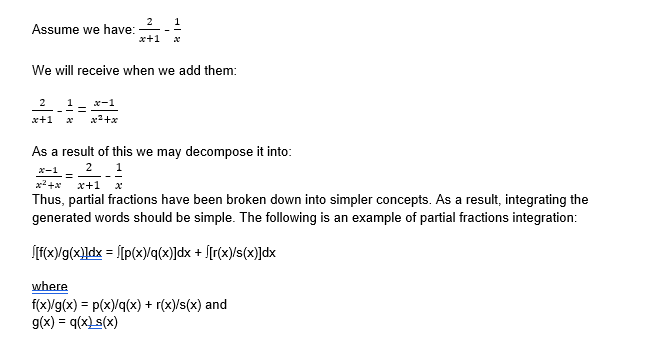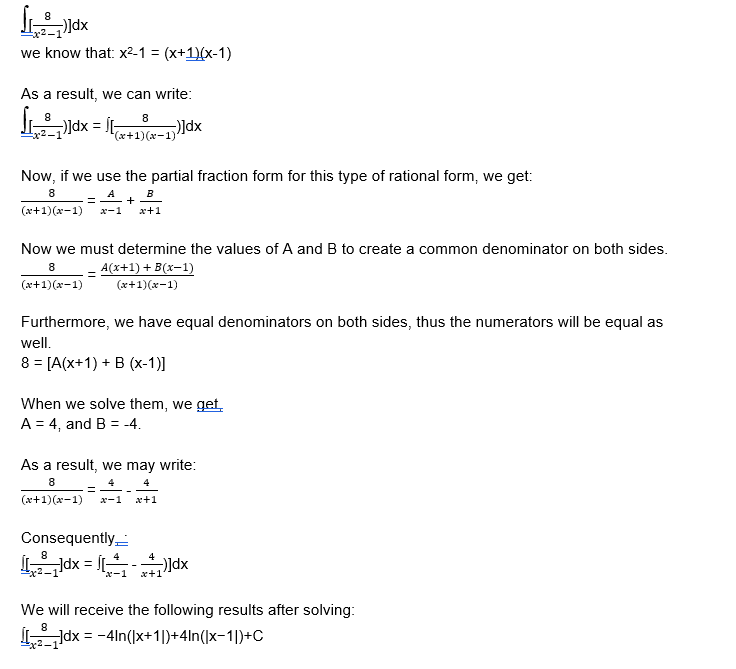A complex rational expression is divided into two or more simpler fractions using partial fractions. In general, fractions containing algebraic expressions are hard to solve; thus, we divide them into several subfractions using partial fractions principles.
During decomposition, the denominator is usually an algebraic expression that is factorised to make the process of obtaining partial fractions easier. A partial fraction is the inverse of the rational expression addition process.
We normally conduct arithmetic operations over algebraic fractions to get a single rational expression. On splitting in the opposite direction, this rational statement included the breakdown of partial fractions, resulting in two partial fractions.
A partial fraction corresponds to each factor in the denominator of a rational statement.
For example, the denominator of (4x + 1)/[(x + 1)(x – 2)] has two factors, resulting in two partial fractions, one with the denominator (x + 1) and the other with the denominator (x – 2).
Partial Fractions from Rational Functions
Rational numbers are any numbers that can be simply expressed in the form of p/q, where p and q are integers, and the value of q cannot be zero. Partial fractions from rational functions are defined in the same way as the ratio of two polynomial functions P(x) & Q(x), where P and Q are polynomials in x and Q(x) is not equal to 0.
In mathematics, a rational function is referred to as proper if the degree of P(x) (upper portion of the fractions) is smaller than the degree of Q(x), otherwise, it is referred to as an improper rational function.
We can convert improper rational functions to proper rational functions using the long division polynomial technique.
Consider the case where the rational fraction is P(x)/Q(x).
If the fraction is improper, it can be stated as follows:
P(x)/Q(x) = A(x) + R(x)/Q(x)
Where, A(x) is a polynomial in x in the given expression, and R(x)/Q(x) is a proper rational function.
We know that the integration of a function f(x) is provided by F(x), and that it may be represented as:
∫f(x)dx=F(x) + C
The integral of f(x) with respect to x is represented by the equation above.
The approach of decomposing and then integrating a rational fraction integrand with complex terms in the denominator is known as integration by partial fractions. We calculate and break down the equation into simpler terms using partial fractions to calculate or integrate the result simply.
The essential notion behind partial fraction integration is to factor the denominator and then partition it into two fractions, where the denominators are factors, and the numerator is appropriately calculated.
Integration by Partial Fractions
One of the three ways of integration is partial fractions integration. We reconstruct the proper rational fraction into a sum of simpler rational fractions using this procedure. A procedure known as partial fraction decomposition can break down a rational fraction into smaller rational fractions.
For example, if we have 5/6, we can break it down as 5/6 = 1/2 + 1/3, and we can do the same thing by algebraically decomposing two partial fractions.

Method of Integration by Partial Fractions
The partial fractions method of integration is a straightforward procedure to calculate manually. However, it can also be evaluated by a partial fraction decomposition calculator. Let us look at an example of the partial fractions integration approach. We have the following:

Partial Fraction Decomposition
A rational function is reduced to a valid rational function in order to integrate it. Decomposition into partial fractions is the approach of expressing the integrand as the sum of simpler rational functions.
Traditional integrating procedures are used to integrate the integrand after it has been broken into partial fractions.
The steps for determining the partial fraction decomposition are listed below:
- Step 1: Start with the right rational expression when decomposing the rational expression into the partial fraction.
- Step 2: Now factor the rational expression’s denominator into a linear factor or irreducible quadratic components (Note: Do not factor the denominators into complex values).
- Step 3: With the variables in the numerators, say A and B, write down the partial fraction for each factor produced.
- Step 4: Multiply the entire equation by the denominator to determine the variable values of A and B.
- Step 5: To solve for the variables, replace the factor variable with zero.
- Step 6: Finally, substitute the values of A and B in the partial fractions.
Thus, the expression is broken down into partial fractions.
Conclusion
A complex rational expression is decomposed into two or more simpler fractions using partial fractions. In general, fractions containing algebraic expressions are difficult to solve; thus, we divide them into several subfractions using partial fractions principles.
If rational functions are integrated into the theory of differential equations, the Inverse Laplace Transform is found.
 Profile
Profile Settings
Settings Refer your friends
Refer your friends Sign out
Sign out






